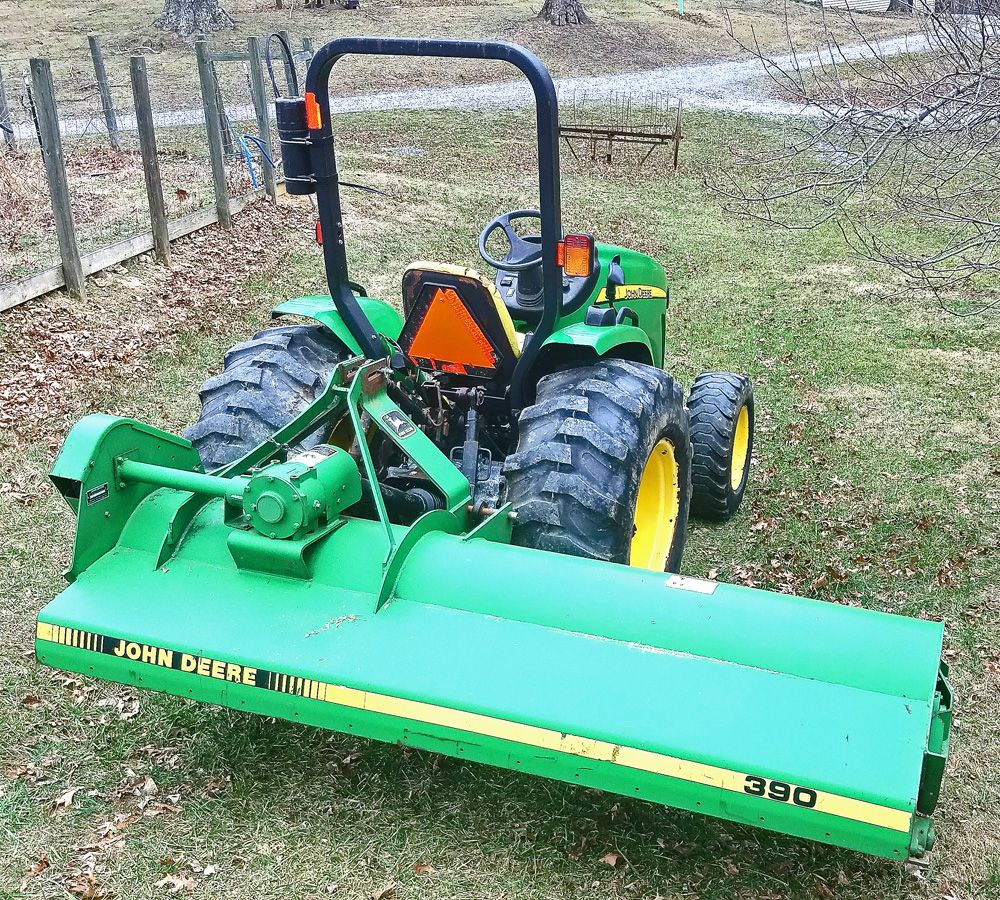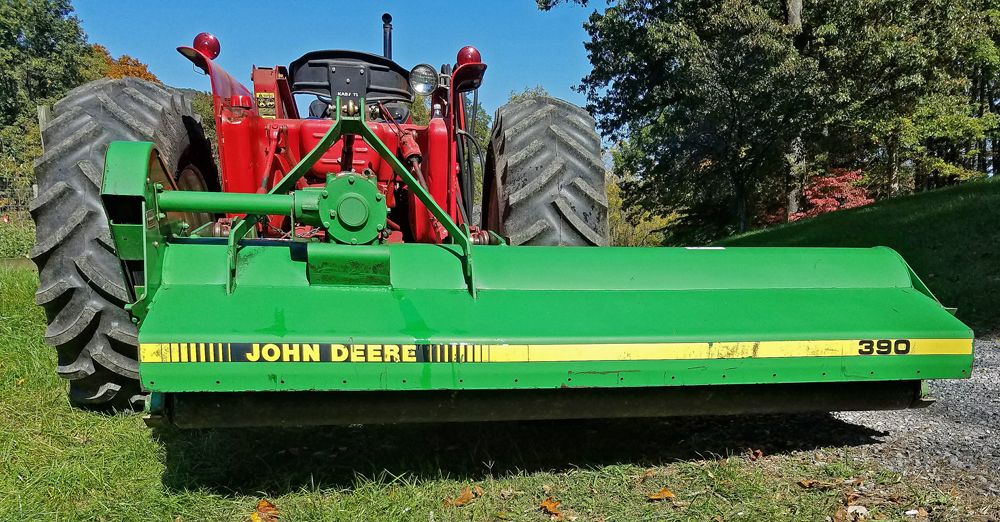Are you going to run any horses or cows? They will eat around fence posts just fine. Leave you manure for the garden. Win win. A Grasshopper mower with the front deck will get under the boards but you'll have a bit around the posts that will need to be trimmed. Play tag team with the wife and trimmer. You'll get it done sooner than you might think.
You are using an out of date browser. It may not display this or other websites correctly.
You should upgrade or use an alternative browser.
You should upgrade or use an alternative browser.
Alternatives for mowing. Other than ZTR and SCUT tractor pulled, what is out there.
- Thread starter Dadnatron
- Start date
- Views: 4291
/ Alternatives for mowing. Other than ZTR and SCUT tractor pulled, what is out there.
#11
RalphVa
Super Member
- Joined
- Dec 19, 2003
- Messages
- 7,901
- Location
- Charlottesville, VA, USA
- Tractor
- JD 2025R, previously Gravely 5650 & JD 4010 & JD 1025R
DR has a pull behind thing that goes under the fence and around posts.
Ralph
Ralph
GirlWhoWantsTractor
Platinum Member
- Joined
- Apr 25, 2015
- Messages
- 948
- Location
- The Mountains of Virginia
- Tractor
- 2018 Mahindra 26XL HST, Husqv GT48XLsi & YTH48LS
Agree with not wanting to use glycophosphate. Stuff grows back soon anyhow, and many weeds (which will take over after the grass is permanently killed) are at least partially immune to it. And I can't see string-trimming "miles of fencerows." Life is too short. 
There are no "easy" solutions but here are a few:
1. Plant a sturdy groundcover like creeping phlox along your fence lines. You'd need to do this in early spring with seeds. Or, plant low growing bushes: berries, forsythia, etc., which will spread. Ornamental grasses also work well as they will spread also. Also you can cut them back in winter and have access to your fences for maintenance.
2. Longer-term, plant rows of trees along the fence rows. Grass/weeds like sun.
3. Shorter-term, in early spring while the ground is still bare, add at least 5 inches of mulch. (If the grass has already grown up, you can weed-wack the grass down to the ground and then put down the mulch; works for us when we've been too busy to stay on top of weeding.) If you want to implement #1 or #2 longer term, the mulch will help keep the grass at bay while your plantings grow.
4. Baking soda will kill everything for a couple of months. Better than glycophosphate but still puts sodium into the soil.
5. Let it grow and then once a year, just before the relatives arrive for a visit, trim it down.
6. Hire a mowing company to maintain it.
We are also getting ready to implement some extensive horse fencing, and I'm aware of the problem (love everything tidy, but hate the hours of tedious work, did I mention life is too short?). I will probably opt for #6 while I wait for #1 and #2 to grow in.
Let's face it, "miles of wooden horse fencing" were easy back in the day when everyone had a couple of gardeners/stablemen to take care of it all.....
Will be curious to see what you decide.
There are no "easy" solutions but here are a few:
1. Plant a sturdy groundcover like creeping phlox along your fence lines. You'd need to do this in early spring with seeds. Or, plant low growing bushes: berries, forsythia, etc., which will spread. Ornamental grasses also work well as they will spread also. Also you can cut them back in winter and have access to your fences for maintenance.
2. Longer-term, plant rows of trees along the fence rows. Grass/weeds like sun.
3. Shorter-term, in early spring while the ground is still bare, add at least 5 inches of mulch. (If the grass has already grown up, you can weed-wack the grass down to the ground and then put down the mulch; works for us when we've been too busy to stay on top of weeding.) If you want to implement #1 or #2 longer term, the mulch will help keep the grass at bay while your plantings grow.
4. Baking soda will kill everything for a couple of months. Better than glycophosphate but still puts sodium into the soil.
5. Let it grow and then once a year, just before the relatives arrive for a visit, trim it down.
6. Hire a mowing company to maintain it.
We are also getting ready to implement some extensive horse fencing, and I'm aware of the problem (love everything tidy, but hate the hours of tedious work, did I mention life is too short?). I will probably opt for #6 while I wait for #1 and #2 to grow in.
Let's face it, "miles of wooden horse fencing" were easy back in the day when everyone had a couple of gardeners/stablemen to take care of it all.....
Will be curious to see what you decide.
CADplans
Elite Member
This is my alternative,,, I have been using it for a decade,,,




TheMan419
Veteran Member
Dr trimmer is on sale!
3-Point Hitch Trimmer Mower: String Trimmer and Fence Mower | DR Power Equipment
I am about to install a couple miles of fence too. Long term going to need a solution because I am not using the string trimmer.
First year I will likely use round up barrier to prevent grow back for a year. That will buy some time.
3-Point Hitch Trimmer Mower: String Trimmer and Fence Mower | DR Power Equipment
I am about to install a couple miles of fence too. Long term going to need a solution because I am not using the string trimmer.
First year I will likely use round up barrier to prevent grow back for a year. That will buy some time.
LMychajluk
Silver Member
Hmmm, That DR page claims both the 175mm and 225mm string is the '...the thickest, longest-lasting in the industry!'. I wonder which it is?
aczlan
Good Morning
- Joined
- Mar 7, 2008
- Messages
- 17,540
- Tractor
- Kubota L3830GST, B7500HST, BX2660. Formerly: Case 480F LL, David Brown 880UE
We have one of the DR fence line mowers, it is very sensitive to ruts in the path where the wheel runs and in our experience if there are any rocks or sticks where is mowing, the line does not last more than 3 fence posts.I've seen those and they, or something like them, might be an alternative. I've just never been impressed with the quality of their cutting. They are certainly better than bulking things out with a string trimmer, no doubt. But I've seem them leave so much around a post, that I'd have to see them working better before I'd head there. At least at this stage.
Again, I'm looking for my 'best' alternative, before I get to the point that I settle.
I've looked at about everything I can find (online/YouTube) and I've seen that one Egon. But it requires both sides of the fence to get anything 'well'. And it still leaves quite a bit around the post. I appreciate the post though.
Someone at one point suggested replacing the line with 1/8” stainless steel cable with the ends heated up with a torch enough to make them melt in a little ball. I have the cable just need to get around to trying it at some point.
Aaron Z
TractorGuy
Elite Member
- Joined
- Sep 15, 2013
- Messages
- 4,616
- Location
- N. FL
- Tractor
- John Deere 4310 CUT, Ford New Holland 575E Industrial Backhoe, John Deere F725 Front Mount Mower
This would be the best design for not damaging trees and fence posts.
I have seen a finish mower with a similar belt driven attachment but can't find it right now. It had the advantage of a 84" cut with the fence attachment hanging off one side that had the rotating rubber rimmed cutter.
I have seen a finish mower with a similar belt driven attachment but can't find it right now. It had the advantage of a 84" cut with the fence attachment hanging off one side that had the rotating rubber rimmed cutter.
aczlan
Good Morning
- Joined
- Mar 7, 2008
- Messages
- 17,540
- Tractor
- Kubota L3830GST, B7500HST, BX2660. Formerly: Case 480F LL, David Brown 880UE
There are a couple of people who make an attachment for a zero turn that does something similar. They are common on mowers that mow in graveyards.This would be the best design for not damaging trees and fence posts.
I have seen a finish mower with a similar belt driven attachment but can't find it right now. It had the advantage of a 84" cut with the fence attachment hanging off one side that had the rotating rubber rimmed cutter.
Aaron Z
MORRISONSTEEL
Platinum Member
I think the original and probably best version of the zero turn mounted trimmer was the Noah mowing system. I had a chance to be around one years ago, it worked quite well. It was marketed to cemetery's heavily as mentioned as it did not do any damage to head stones, at that time it was only for commercial z's as it was quite heavy. Noah no longer exists, the original inventor suffered a health problem and the company was sold. I am not positive but I think it was bought by pal mowing systems.
